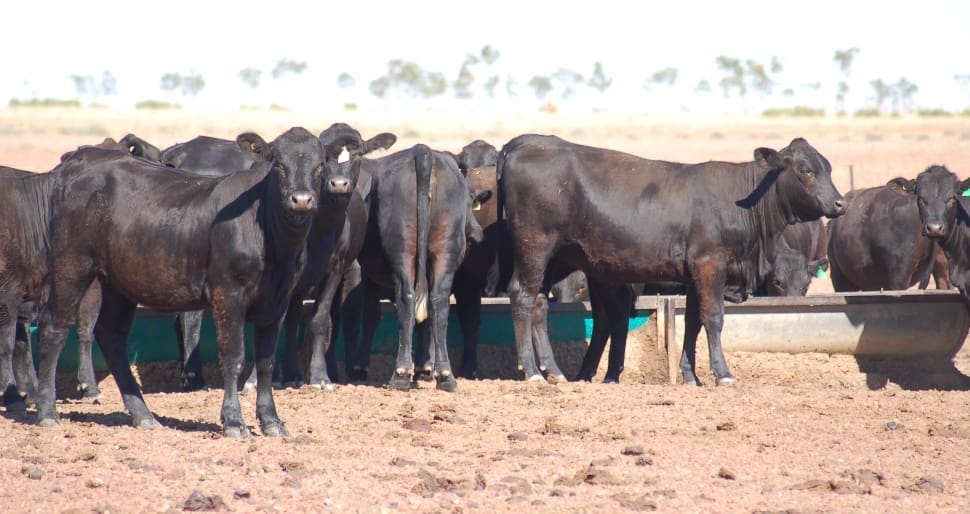
Wagyu F1 calves on AA Co’s Avon Downs station on the Barkly Tableland
The Australian Agricultural Co has delivered a strong operating profit of $24.4 million for its full 2020-21 financial year ended 31 March – up from $15.2 million a year earlier.
The world’s largest cattle business also delivered a positive operating cash flow of $18.4 million and a statutory pre-tax profit of $99.3m, despite a year that was made more challenging and uncertain by COVID and in the face of headwinds that impacted red meat production, and are likely to continue to do so through the current trading year.

AA Co’s Hugh Killen
Managing director and chief executive Hugh Killen told an analysts’ briefing this morning that it had been a solid year for the company, under the circumstances.
“This year will go down as one of the most challenging on record for many companies and AA Co is no different, so to post a positive result is commendable,” Mr Killen said.
“The fundamentals of the business remain strong and we’ve made progress with our brands, which is encouraging considering the ongoing challenges that we will navigate over the coming few years.”
A significant reduction in expenditure, improved beef price per kilo and further progress in the goal of making AA Co a ‘simpler, and more efficient business’ helped deliver this year’s result.
Meat sales volume down, but average price up
Milestones were reached during the year, including reaching a net asset value above $1 billion for the first time, following increases in herd value (up $64m to $537m) and property (up $106m to $979m) following valuations.
Meat sales volume was down 19pc for the year due to the impact of earlier drought and flood events on breeder numbers and calving rates, and this is expected to continue into the current trading year.
Offsetting this was an 8pc improvement in average meat sales price per kilogram, further underpinned by progress made in AA Co’s branded beef strategy. Further rationalisation of the supply chain’s brand portfolio was made, with Westholme and Darling Downs Wagyu brands now accounting for 74pc of AA Co’s branded meat sales.
“We’ve focused this year on strategic market allocation and adapting our channel strategy to satisfy the rise of at-home consumption and the home chef,” Mr Killen said.
Trade access issues and COVID had contributed to some changes in export focus, with value of beef sales to China (principally beef trim) falling from 15pc to 6pc of overall sales last financial year, while gains were made in North America (up from 7pc to 19pc of sales) and other parts of Asia (up from 51pc to 55pc).
Branded beef price per kilo was up 14pc in North America, compared to FY20, driven by a successful growth into retail channels during COVID and a focus on digital and social campaigns to drive brand awareness. While total meat sales fell across Asia and Australia, both achieved a 5pc improvement in price per kilo compared to FY20.
Sales into Europe and the Middle East were directly impacted by COVID’s effect on food service, with the closure of restaurants and hotels. At the same AA Co’s major retail focus last financial year was Asia and North America, resulting in a drop in the proportion of AA Co meat sales going to Europe.
While some 80pc of rump and loin cuts produced by the company are now sold under company brand programs and 55pc of BBQ and secondary cuts, the 35-40pc of every carcase that goes into trim was an area of opportunity.
“At present, the vast majority of trim is sold as a commodity, with little product innovation or added brand value. This suggests there is potential to improve the value we write from this category, and it is an area of potential growth that we will be exploring in the future.”
COVID-19
Mr Killen said AA Co had done well to navigate through the initial challenges associated with COVID and the company would continue to monitor and adjust to changes in its markets and the wider economy through the current financial year.
“The last 12 months have been dominated by uncertainty across many industries and ongoing disruption across our key markets around the world,” he said.
“These risks continue, despite positive progress in virus suppression in parts of the world.”
Industry outlook
He said the Australian cattle industry was also being impacted by other external forces, including reduced herd size as a result of historic tumultuous seasonal impacts in droughts and flood.
“Much attention has been on the EYCI, but the record-setting level is largely a consequence of supply and demand, with fewer cattle for Queensland producers who are looking to restock,” he said.
Meat & Livestock Australia had revised down cattle slaughter forecasts to their lowest level in 36 years this year and a fall of 11pc on 2020 levels. The national cattle herd was also coming off its lowest level in 25 years, in 2020.
Impact on AA Co
Mr Killen said a number of AA Co properties were seeing below average rainfall and the Gulf properties were still recovering from the 2019 flood, with limited pasture response.
“These headwinds have started to impact our meat production in FY21 due to our average F1 Wagyu lifecycle length of 3.5 years from conception through to backgrounding, feedlots and processing,” he said.
This had translated into 19pc lower meat volumes sold last financial year, with lower sales volume likely to continue this year.
“Importantly though, our herd rebuild has commenced, with a 47pc increase in calves last financial year, compared with a year earlier.”
Notwithstanding these headwinds, Mr Killen said progress had been made on the branded beef strategy, which remained fundamental to AA Co and would continue to help the company navigate through the uncertain environment.
“Being able to make progress in a year that was so heavily affected by outside factors shows that it’s the right approach and should remain central to our activities,” he told analysts this morning.
“Our strong brand portfolio and distribution partnerships have helped us connect with new customers and respond to changes in our markets in FY21, and has helped us deliver the improvement seen in average meat sales price per kilogram.
Carbon project included under sustainability focus
AA Co is due to release its second sustainability report in July, detailing its progress over the past 12 months.
One of the key developments this year has been the introduction of AA Co’s Beef Cattle Herd Management Carbon Project, a new program targeted at carbon abatement registered under the Australian Government’s Clean Energy Regulator’s BCI-M carbon methodology. Other sustainability progress has focused on animal health and welfare, including the establishment of an internal company Animal Health and Welfare committee, further progress in the poll breeding program, and a doubling in use of solar-panel powered bores.
Argentina export ban impact
During questions, an analyst asked what impact this week’s Argentina export withdrawal could have on world markets, and AA Co specifically.
“The Argentina situation is an interesting one. We have seen immediate moves in the beef trim pricing complex, which shifted higher overnight (see yesterday’s Beef Central story).”
“But stepping back and looking at where things are at, from an Australian perspective, we are in herd rebuilding, meaning supply through to processing is extremely challenged, and that will continue for a while longer. Brazil has killed 1.5 times its normal throughput last year, going heavily into their breeding herd, and now Argentina has significant issues.
“These are all really positive aspects for pricing, and global red meat sales. The US, on the other hand, has been in a cull phase, killing off their herd at a higher rate due to a drought event, delivering very good profits for processors. But there are forecasts of a break in the season in the US, which could produce a rapid turnaround in that trend.”
“Put all that together, including Argentina, and China’s continued problems with African Swine Fever, and the demand for red meat globally could see prices move higher over the next six months.”
